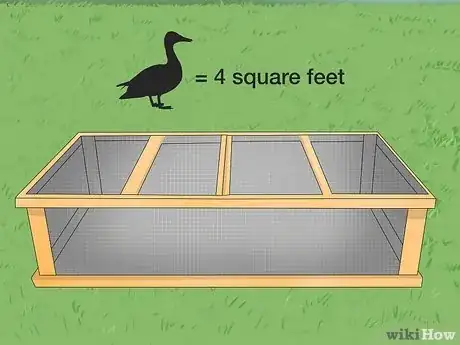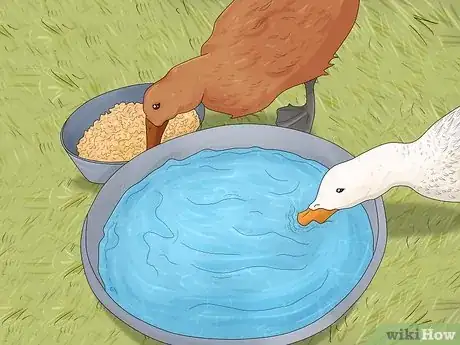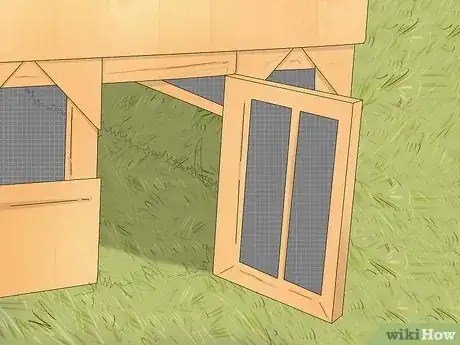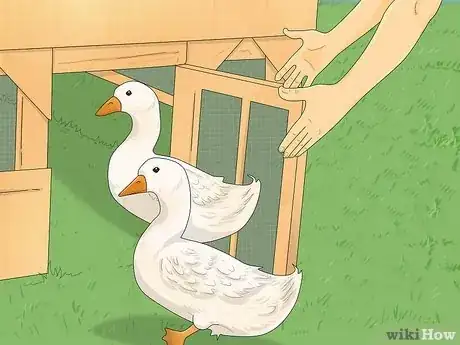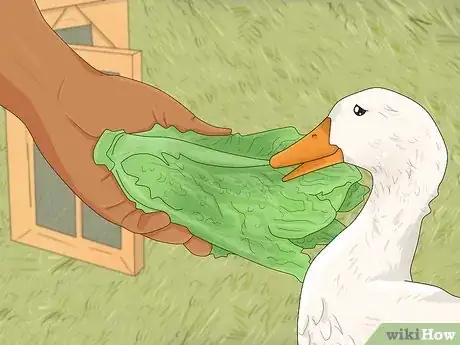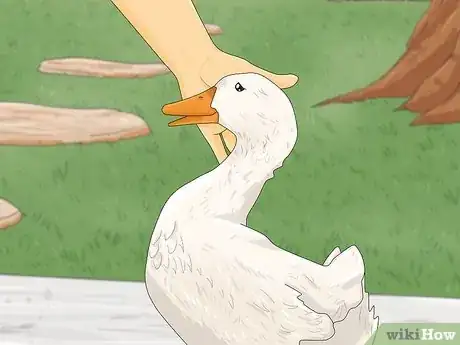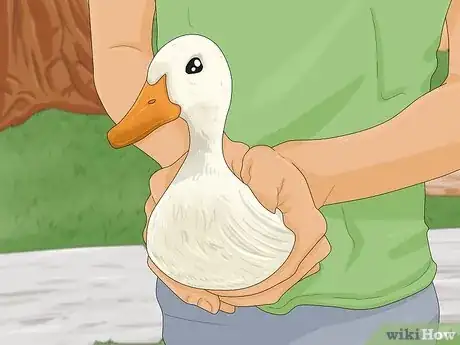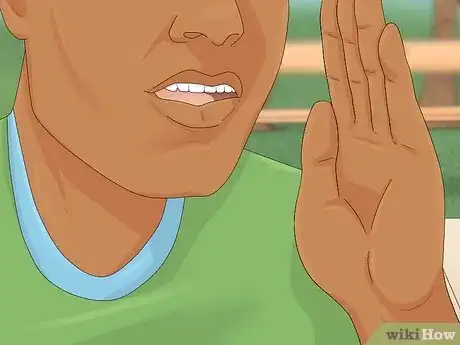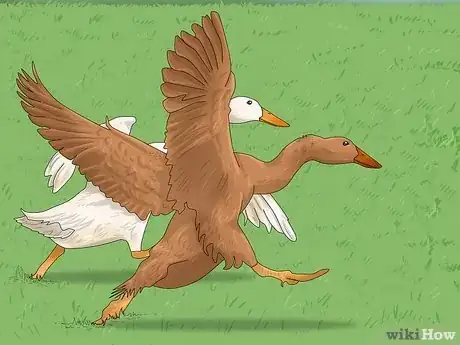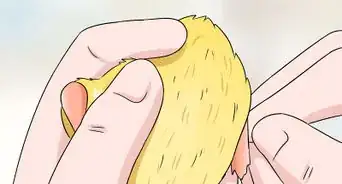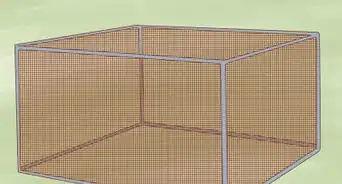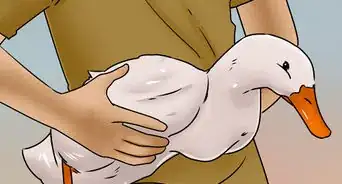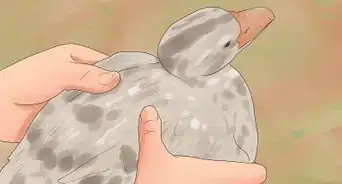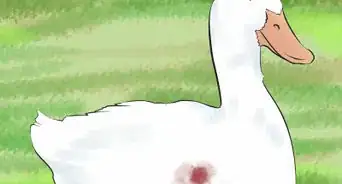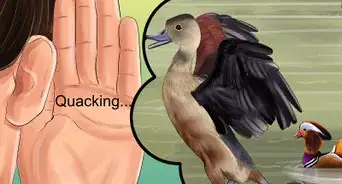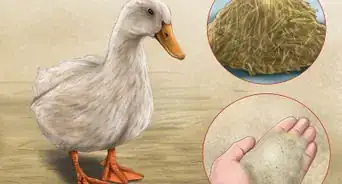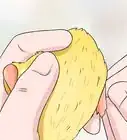This article was co-authored by wikiHow Staff. Our trained team of editors and researchers validate articles for accuracy and comprehensiveness. wikiHow's Content Management Team carefully monitors the work from our editorial staff to ensure that each article is backed by trusted research and meets our high quality standards.
There are 12 references cited in this article, which can be found at the bottom of the page.
This article has been viewed 138,139 times.
Learn more...
It may come as a surprise, but ducks are actually quite trainable. With the right motivation and a little patience, you can teach your pet ducks to free range and return to their pens on their own, become comfortable being petted and held, and even respond to their names. The key is to get them used to certain conditioning techniques little by little until they begin adapting to them.
Steps
Encouraging Your Ducks to Free Range
-
1Keep new ducks confined to their pen for one week. When you first bring a litter of ducklings home, get them situated in their pen and let them spend most of their time there. This will give them a chance to get familiar with their new surroundings. Before long, they’ll begin to identify the pen as a safe shelter to return to.[1]
- Make sure the pen you have set up is large enough to comfortably house all of the ducks you’re keeping. A good rule of thumb is to provide at least 4 square feet (about 0.37 square meters) of space per animal.[2]
- It's also possible to train adult ducks to free range, although it may take them a little longer to catch on.
-
2Make your ducks’ pen as comfortable as possible. Cover the floor with a thick layer of grass or straw to give your ducks a cozy place to nestle. Set out containers for a quality duck feed and fresh, clean water and keep them well-stocked. They should have all of their basic needs met the entire time they’re restricted to their pen.[3]
- Newborn chicks and growing ducklings may benefit from having a space heater or heat lamp positioned nearby during the colder months of the year.
- Be sure to clean out any messes your ducks happen to make on a daily basis so they aren’t cooped up with their own filth.[4]
Advertisement -
3Start leaving the door of the pen open after a week. Following the initial acclimation period, allow your ducks to come and go as they please. They may be somewhat reluctant to leave at first. With time, however, they’ll get over their fear and take more of an interest in the world outside.[5]
- Don’t try to force your ducks out of their pen. They’ll make their way out on their own when they’re ready.
- Young ducks are typically more willing to venture out of their pen when there are other adult ducks outside. If you don't own any other ducks, a handful of mealworms will usually do the trick.
-
4Usher your ducks back into their pen at night. More often than not, they’ll instinctively return to shelter once dusk arrives, but if they seem confused or inattentive, they may need a little guidance. Use a long stick or pole to calmly direct your ducks back towards the opening of the pen. Once they're inside, leave the door open so they can begin getting used to coming and going as they please.[6]
- Don’t use your herding tool to physically move the ducks. Doing so could hurt them or send them into a frightened frenzy.
- Ducks have a tendency to group up and follow one another, so they shouldn’t need too much coaxing.
-
5Repeat this routine for as long as needed. Turn your ducks loose to wander freely during the day and corral them back into their pen come nightfall. They’ll catch on after a couple of weeks. After that, it may not be necessary to ever close them up again!
- Even if you decide to train your ducks to free range, it’s a good idea to keep them shut up within in a large enclosure to prevent them from getting lost or nabbed by predators in the area.[7]
- Allowing your ducks to roam is good for them. It gives them some much-needed exercise, keeps them well-fed, and helps control populations of common pests like beetles and slugs.
Hand Training Your Ducks
-
1Grab a handful of treats. Sprinkle some live mealworms or a few pieces of shredded romaine lettuce into the palm of your hand. You’ll use these treats to entice your ducks into coming close enough to touch.[8]
- Ducks also love to nibble on fresh foods like fruits, vegetables, herbs, and whole grains. Seeds, berries, beans, corn, and leafy greens are among their favorites.
- Contrary to popular belief, ducks should never be fed bread products (such as sliced bread, bread crumbs, or crackers). Starchy, nutrient-poor foods can be bad for their health.[9]
- Produce items like onions, nuts, and citrus should also be avoided, as they can be hard for ducks to digest or present a possible choking hazard.
-
2Pet your ducks gently while they eat out of your hand. As the ducks come closer to investigate the treats, hold out your other hand slowly and use it to stroke or tickle their heads. They’ll be so focused on the food that they won’t consciously register being touched. However, some light petting will calm their nerves and prime them for more prolonged contact in the future.[10]
- Don’t reach for your ducks too quickly or forcefully—since they're natural prey animals, this will more than likely scare them away. Instead, let them come to you.
- It’s important to handle ducks with care, especially when they’re young.
-
3Work your way up to picking up your ducks. When one of your ducks comes within grabbing range, place a hand over either of its wings and lift it gently from above. Be sure to keep one arm underneath the duck's body to support its weight and keep its legs secured. Speak soothingly to it and release it after a few short moments.[11]
- Ducks typically tolerate being petted pretty well, but it may take them a while to warm up to being held. Try petting them with both hands or coaxing them into your lap with treats first.
- If your ducks don’t want to be held, let them go. Seizing them by force will only teach them to panic when picked up.
-
4Hold your ducks for longer periods of time. Eventually, your ducks will become so used to being touched that they’ll no longer be skittish when they see you're reaching out for them. You’ll then be able to pick them up to clean them, corral them, or just to show them some affection.[12]
- Ducks are usually very calm when held like a small dog or cat.[13]
Getting a Duck to Respond to Its Name
-
1Name your duck. Before you can teach it to react to its name, it needs to have one. Pick out one of your favorite names for your duck based on its sex, or come up with names that have a more playful ring to them, such as “Mother Goose” or “Quack Nicholson.”
- You can also assign a name to your duck based on its physical characteristics. For instance, you might name a solid white bird “Snowflake,” while an especially small one could be called “Peanut.”
- Be creative and don’t be afraid to get a little silly. Ducks can be fun pets, too!
-
2Call your duck by its name as often as possible. Get in the habit of using your duck’s name anytime you’re interacting with it. This could be while you’re feeding, petting, bathing, or leading it back to its pen at the end of the day. Be sure to address it in a clear tone of voice so it knows you’re talking to it.[14]
- If you have multiple ducks, you might have success teaching them to respond to different names by using a certain name whenever you're interacting with them one-on-one.
- Feel free to repeat your duck’s name as frequently as you want. Even if it doesn’t understand what you’re saying, the sound of your voice can be very relaxing for it.
- Ducks are quick learners. The more often you refer to them by name, the faster they’ll come to associate that name with a particular stimulus like food.
-
3Try calling your duck to you. Every so often, stand at a distance from your duck and say its name in a clear voice. After hearing it enough times, there’s a good chance it will recognize the sound and come to you. If it doesn’t, it may be in need of further conditioning.
- With consistent training, your duck will gradually begin to pick up on its name the way chickens and other farm birds do.
Community Q&A
-
QuestionMy four month old female duck laid an egg yesterday. Do I have to make a nesting area? She does sleep in my home at night in a zippered pen.
 Community AnswerWhen your birds start laying, they like to do it in a small dark area. You don't have to make a nesting box, but you should provide an area where she can lay privately.
Community AnswerWhen your birds start laying, they like to do it in a small dark area. You don't have to make a nesting box, but you should provide an area where she can lay privately. -
QuestionDo ducklings need to stay inside until they've grown to a certain age or no?
 Community AnswerYou need to keep it inside an enclosed warm area for a month or two. Then make a pen outside for them, but I would advise you give them a mother AND father to adopt them if you don't already have a pair.
Community AnswerYou need to keep it inside an enclosed warm area for a month or two. Then make a pen outside for them, but I would advise you give them a mother AND father to adopt them if you don't already have a pair. -
QuestionI have two 6 week old ducklings who are in with an older goose, but whenever I go to pet them the goose starts to hiss and protect them. Any advice?
 Community AnswerYour goose is starting to think they are her group of friends. You will have to pay more attention to the goose in hopes of becoming part of her group. Otherwise, separate her before handling the ducklings.
Community AnswerYour goose is starting to think they are her group of friends. You will have to pay more attention to the goose in hopes of becoming part of her group. Otherwise, separate her before handling the ducklings.
Things You’ll Need
- Mealworms or other live feed (for treats)
- Long stick or pole
- Grass or straw
- Feed and water containers
- High-quality duck feed
References
- ↑ https://www.selfsufficientculture.com/threads/how-to-train-ducks-to-free-range-return-to-their-pen.920/
- ↑ https://morningchores.com/duck-coop-considerations/
- ↑ https://thefreerangelife.com/raising-ducks/
- ↑ http://www.wideopenpets.com/10-tips-perfect-duck-coop/
- ↑ https://morningchores.com/about-raising-ducks/
- ↑ https://www.selfsufficientculture.com/threads/how-to-train-ducks-to-free-range-return-to-their-pen.920/
- ↑ https://timbercreekfarmer.com/free-range-ducks/
- ↑ http://www.thecapecoop.com/treats-ducks-will-love/
- ↑ https://www.popsci.com/feeding-ducks-bread
About This Article
With a little patience and the right technique, you can train your duck to eat out of your hand, be comfortable with petting, and respond to its name. Try offering your duck treats like mealworms, seeds, fresh fruit, and vegetables in the palm of your hand. When it comes closer to eat the treat, gently stroke or tickle its head. The more you do this, the more comfortable it'll be with you touching and feeding it. Once it's used to being touched, you can try picking it up and holding it for a short while. You can also train your duck to respond to its name at the same time. Just use your duck's name while feeding and petting it. After a while, it'll get used to its name and start to come when you call it. For more tips, including how to train ducks to come out of their pen, read on!
